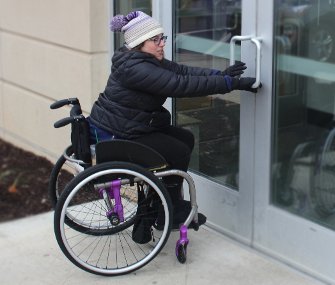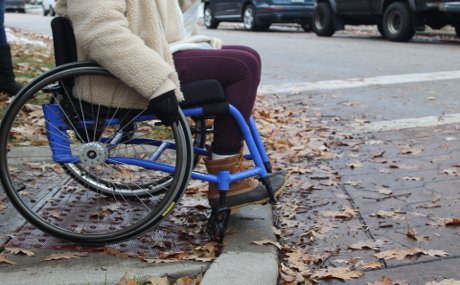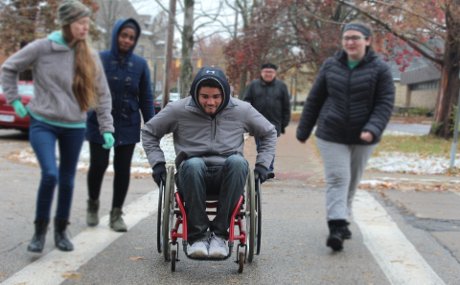 Walking
is
a
gift
that
the
majority
of
people
take
for
granted,
but
students
in
one
sociology
class
at
Baldwin
Wallace
University
had
an
eye-opening
experience
thanks
to
education
major
Melanie
Greenberg
'20.
Walking
is
a
gift
that
the
majority
of
people
take
for
granted,
but
students
in
one
sociology
class
at
Baldwin
Wallace
University
had
an
eye-opening
experience
thanks
to
education
major
Melanie
Greenberg
'20.
Greenberg, who has been in a wheelchair since she was young due to an accident, decided that her final project for professor Elizabeth Ross' sociology class would be the perfect opportunity to help her peers and professor get an insight on her life.
To conduct an accessibility challenge, Greenberg contacted Youth Challenge, an organization that brings together young people with physical disabilities and teen volunteers who inspire each other through adapted sports, recreation and social growth activities. They provided five wheelchairs to the class for a day. She divided the class up into groups of five to rotate using the wheelchairs. For each group, Greenberg drew up a route around campus with several stops along the way.
The routes made evident that sidewalks around BW include cracks, bumps and inconsistencies in the concrete. Students who walk would normally go over these bumps with little to no thought, but in a wheelchair, they presented big problems.
 In
addition
to
the
bumpy
rides,
most
of
the
buildings
around
campus
only
have
one
handicap
entrance.
This
makes
it
difficult
for
people
in
wheelchairs
to
get
into
buildings
and
make
it
to
class
on
time.
Some
of
the
buildings
have
handicap
entrances
in
hidden
spots
that
you
would
never
see
if
you
didn't
ask
someone
where
it
was.
In
addition
to
the
bumpy
rides,
most
of
the
buildings
around
campus
only
have
one
handicap
entrance.
This
makes
it
difficult
for
people
in
wheelchairs
to
get
into
buildings
and
make
it
to
class
on
time.
Some
of
the
buildings
have
handicap
entrances
in
hidden
spots
that
you
would
never
see
if
you
didn't
ask
someone
where
it
was.
A simple 10-minute walk from one class to another is a near 30-minute expedition for a student in a wheelchair with the additional obstacles of snow, passing students and cars.
 One
of
the
biggest
student
takeaways
from
the
experiment
was
that
moving
in
a
wheelchair
takes
a
lot
of
upper
body
strength.
To
cover
the
assigned
routes,
groups
had
to
rotate
each
person
in
the
wheelchair
at
least
twice
because
the
effort
was
so
tiring
for
their
arms
and
hands.
Afterward,
Greenberg's
peers
commended
her
for
her
immense
strength.
One
of
the
biggest
student
takeaways
from
the
experiment
was
that
moving
in
a
wheelchair
takes
a
lot
of
upper
body
strength.
To
cover
the
assigned
routes,
groups
had
to
rotate
each
person
in
the
wheelchair
at
least
twice
because
the
effort
was
so
tiring
for
their
arms
and
hands.
Afterward,
Greenberg's
peers
commended
her
for
her
immense
strength.
Greenberg has had to alter her life in order to accommodate her disability, but she is now confident and comfortable saying it is a part of who she is.
People who have the ability to walk can never truly understand the struggles of living day-to-day life in a wheelchair. Yet, Greenberg's social experiment helped everyone get to know and respect how her life works just a little bit better than they did beforehand.